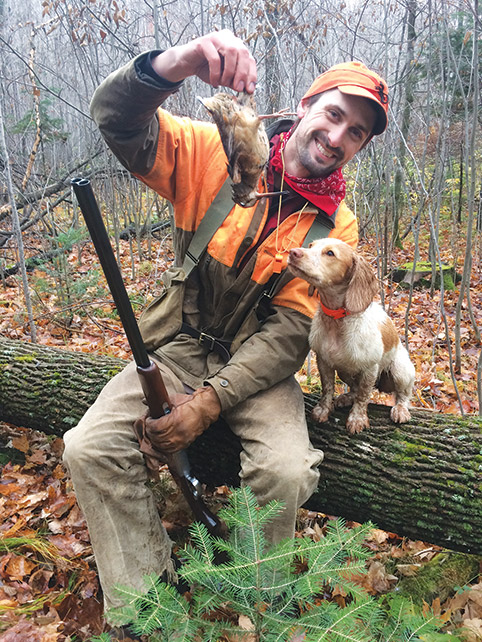 Hunting: English Cocker Spaniel
Hunting: English Cocker Spaniel
By Phil Goes
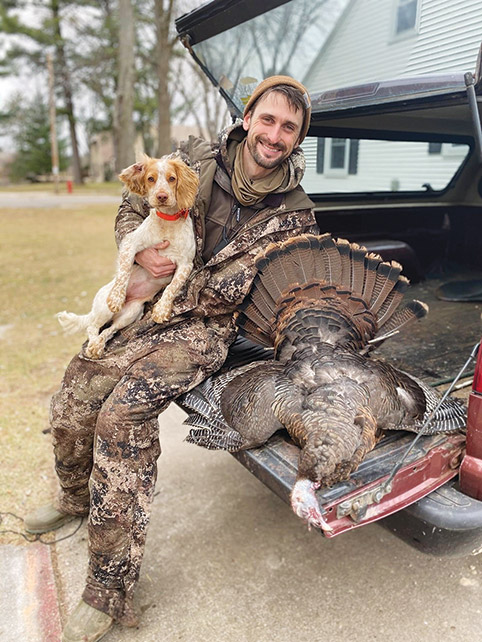
The guy asked if June was a real hunting dog, and when I spun around to let him have a piece of my mind, he saw the fire in my eyes and stammered, “Er … I mean, is that a hunting breed?”
“Yes,” I replied. I thought about adding a comment about his out-of-shape dog but bit my tongue. I couldn’t fault the guy. I, too, had my doubts before I took a deeper dive into field-bred English cocker spaniels. The name made me think of the American cocker spaniel, a dog with a pushed-in face, long ears, and flowing coat bred for parading around show rings.
When I finally met a live English cocker in the field, I knelt down to pet the friendly dog but pulled back upon seeing that the dog’s face was rubbed raw from working through the brush. You need to know when to call it quits before an English cocker runs itself ragged. The owner of this cocker, an older gentleman, held a battered 870 in one hand, a brace of roosters and a rabbit in the other.
“Looks like you did pretty well this morning,” I commented.
“Yeah,” he responded, “that dog hunts like a witch!”
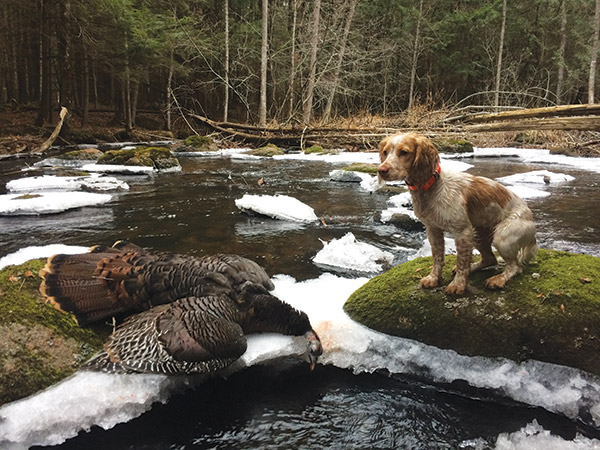
I have no idea what it means for a dog to hunt like a witch, but a field-bred English cocker will hunt about anything you want it to hunt. Primarily an upland bird dog, they don’t mind retrieving a duck or flushing rabbits. They aim to please.
When my Brittany passed away an English cocker wasn’t on my list. But as I learned more about the breed, one of the little spaniels started to sound like what I wanted, a dog that would hunt early season waterfowl and then upland birds and rabbits.
Most importantly, the pup had to be a pal to my two boys, ages 2 and 4.
I found a breeder I liked, and then due to Covid-19 concerns, bought a pup based on texted photos and messages. The breeder assured me “the hunt” was so bred into the dogs that any pup from the litter would be excellent. We picked up our 8-week-old pup in June, and by September, I already knew I had a flushing dog that could not only find birds but also deliver them to hand. June, as we called her, was a natural retriever. At 10 weeks, she was fetching all sorts of things. At 13 weeks, she was bringing back the fresh pigeons I planted in thick brush. What surprised me was how soft of a mouth she had for such a driven dog. At 14 weeks, she completed a 300-yard sit-stay, something I would have never thought possible for such a young dog with an amateur trainer like me.
Originally selected from litters of springer spaniels, founders of the breed wanted a small dog that could slip through thick cover. The name cocker is short for woodcocker, and on June’s first hunt I shot a limit of woodcock over her; she also flushed several grouse. “She’s hunting more like a five-year-old dog than a five-month-old puppy,” my dad commented.
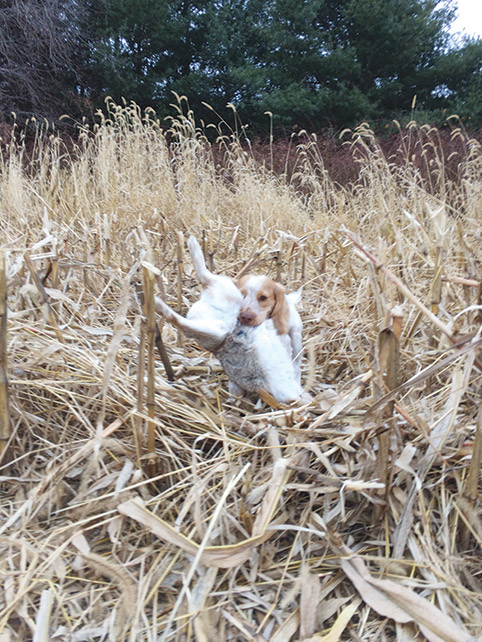
They may be small at 19 to 40 pounds, but they are plenty tough. June made her first water retrieve at five months, and while it wasn’t pretty, the 18-pound pup brought in a mallard that appeared to be as big as her.
In England, cockers are bred for what they call general rough shooting—the idea being that you head out with a shotgun and hunt whatever is available, which makes June a perfect fit for me.
English cockers make good rabbit dogs, but they do not scent trail like beagles. With a cocker, it is all jump shooting. A well-trained cocker is “hupped” when the rabbit breaks (told to sit by voice or whistle), and then the hunter takes a clear shot at the running rabbit.
June is still working on the hup part. The excitement gets her every time, and I can tell when she is on a rabbit by her excited yips. Maybe not the song of a beagle, but that eager racket gets my blood pumping. She storms into a briar patch and then worms her way through every inch.
The size of an English cocker is also an asset when hunting out of boats. Put a 70-pound Labrador in a duck skiff and there isn’t much room for anything else. With a cocker, it’s like adding one more decoy to the cargo.
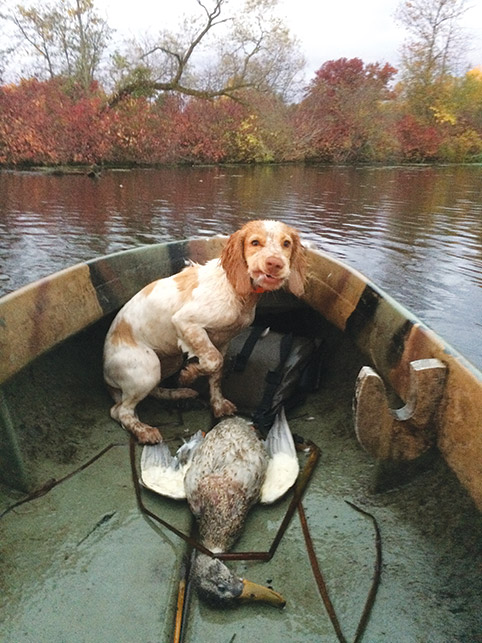
I felt no qualms taking June out in a small skiff, even when she was bouncing around to check out flushing coots and herons. A Lab or Chesapeake doing the same might have swamped the boat.
By late fall I thought June ought to be able to do everything expected of a good turkey dog, that is break up flocks and then sit quietly as I call them back. The slightly larger Boykin spaniel is used this way, so why not an English cocker?
I took her out for turkeys on a bleak Saturday in early December. We entered the woods well before dawn, and about a half-hour before sunrise, the turkeys started talking. It soon became apparent they were not where I thought they should be, and they weren’t headed our way. Rather, they had flown down on the other side of a creek and were angling away.
I tried coaxing them over with kee-kees and hen yelps while June sat patiently, like she was waiting for me to realize it would be up to her to make something happen. As soon as I released her she scented the birds and was off.
Maybe 30 seconds later, alarm putts and the beating of wings filled the air. I heard June splash across the stream and then more pandemonium came from the other side. After busting the flock, she had “treed” a hen that flapped up to a branch and then stood looking down on the yapping devil. The plan may have been to call birds back and shoot one. But I was raised hunting for the table, and this was a good opportunity to bag a bird. While the hen was focused on the dog, I shot it from the other side of the little creek.
Then I hustled as fast as I could to get the downed bird. June was hanging on like a weasel hangs onto a chicken it is trying to kill. I picked up the bird with the dog dangling from one wing.

Spaniels do have drawbacks. Their coats are burr-magnets. I manage that by keeping June’s coat short and diligently removing all burrs the same day. Cockers can’t handle icy water like bigger, hardier retrievers. A neoprene vest might help here, but I haven’t been able to find one that truly fits June.
I read that English cockers don’t respond to harsh training, and I never saw the need to put a shock collar on June. Once she knew what I wanted, she did it. I’m not saying she hasn’t tested my patience, but if she is misbehaving, it’s usually my fault, as happened when I took her out to shoot pigeons over decoys.
The idea was to get her comfortable hunting out of a blind and also get her a lot of retrieves and chances to redeem herself. But as the first flock settled over the decoys, the pup, which had been sitting patiently in the blind, bolted. The birds took off low and slow, and the inexperienced dog gave chase. After several laps in the cut corn, she finally realized it was futile.
With that lesson behind us she completed three dozen retrieves, quickly figuring out that if she wanted to get another one, she had to hustle back to her blind (a plastic dog kennel I had painted brown). We still have a lot of work to do, but she is coming along nicely.
She responds to hand signals and can take a “line” on blind retrieves. She may be a bit sloppy about it, but keep in mind that at the time of this writing, she was 8 months old.
The breeder did warn me that English cockers don’t love retrieving as much as Labradors and can bore quickly with repetitive training. Yet June still cannot get enough of fetch—maybe she is the exception to the rule.
June has become a true member of the family, spending a good part of every day wrestling with my boys. Her size makes her ideal for our home. She’s too short to counter-surf for goodies, and it’s amazing how much gear we can haul when the back of the station wagon isn’t dominated by a large dog crate.
She needs exercise, but nowhere near as much as a pointer or setter. At the end of our 4-mile nightly walk (taken where she can get plenty of time off-leash), she is ready for more but content. In the field, she hunts until I call it quits. I ask a lot of her—too much for such a young dog—yet she rises to the challenge. My wife calls her “The Unicorn Dog.”
She performed spectacularly on our last grouse hunt, flushing 10 that morning. In ruffed grouse fashion, all but one flew away without being seen. I dropped that one a couple yards off the trail. I don’t hit many grouse, and this was a true trophy for me. I had a decent mark on the bird, so I called June over, gave her a line, and she started searching. But she wasn’t interested in looking where I told her to look, and time and time again I called her back and told her, “Find the bird!”
When I put down the gun and started looking on my own, she trotted off. A minute later, she was running toward me with a very live grouse flapping in her mouth. The same lesson had been taught me by each of my previous gun dogs:
Always trust your dog.
I told myself years ago that I would forever be a Lab guy. Then I got a Brittany, and I was sold on that breed. Now, looking down at my little lemon and white dog, it’s hard to imagine hunting or sharing a home with anything else.
Field-bred English cockers are gaining in popularity for good reason: they really can do it all.
